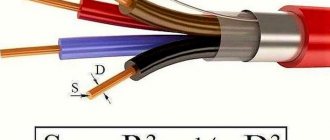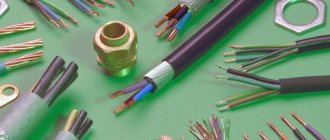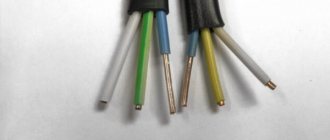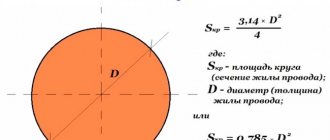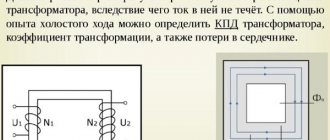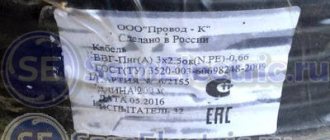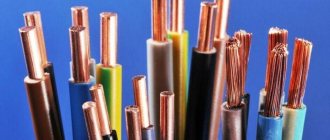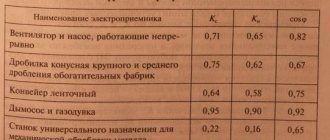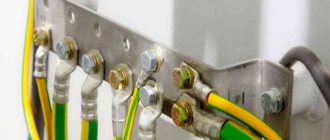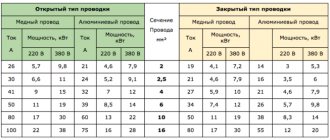General information about cable and wire
When working with conductors, it is necessary to understand their designation.
There are wires and cables that differ from each other in their internal structure and technical characteristics. However, many people often confuse these concepts. A wire is a conductor that has in its design one wire or a group of wires woven together and a thin common insulating layer. A cable is a core or a group of cores that has both its own insulation and a common insulating layer (sheath). Each type of conductor will have its own methods for determining cross sections, which are almost similar.
Conductor materials
The amount of energy that a conductor transmits depends on a number of factors, the main one of which is the material of the current-carrying conductors. The following non-ferrous metals can be used as the core material of wires and cables:
- Aluminum. Cheap and lightweight conductors, which is their advantage. They are characterized by such negative qualities as low electrical conductivity, a tendency to mechanical damage, high transient electrical resistance of oxidized surfaces;
- Copper. The most popular conductors, which have a high cost compared to other options. However, they are characterized by low electrical and transition resistance at the contacts, fairly high elasticity and strength, and ease of soldering and welding;
- Aluminum copper. Cable products with aluminum cores coated with copper. They are characterized by slightly lower electrical conductivity than their copper counterparts. They are also characterized by lightness, average resistance and relative cheapness.
Some methods for determining the cross-section of cables and wires will depend specifically on the material of their conductor component, which directly affects the throughput power and current strength (method of determining the cross-section of conductors by power and current).
History [edit | edit code]
In 1826, Georg Ohm experimentally discovered the basic law of an electric circuit, learned to calculate the resistance of metal conductors and derived Ohm's law. Thus, in the first period of development of electrical engineering (1800–1831), the prerequisites were created for its development and for subsequent applications of electric current.
The very concept of “resistance” appeared long before the research of Georg Ohm. This term was first applied and used by the Russian scientist Vasily Vladimirovich Petrov. He established a quantitative dependence of the current on the cross-sectional area of the conductor: he argued that when using a thicker wire, a “stronger effect... and a very rapid flow of the galvanic-Volta fluid” occurs. In addition, Petrov clearly pointed out that as the cross-section of the conductor increases (when using the same galvanic battery), the current strength in it increases. [2]
Features of electrical wires
With all the variety of cable products and a huge selection of wires for laying electrical networks, there are selection rules. It is not necessary to memorize all brands of cables and wires; you need to be able to read and decipher their markings. First, it’s worth figuring out the difference between a wire and a cable.
Wire – A conductor used to connect two sections of a circuit. May have one or more conductive wires. The veins can be:
- naked;
- isolated;
- single-core;
- stranded.
Bare lines are used where touching live wires is impossible. In most cases they are used for overhead power lines.
The insulating coating is used in one or two layers. Wires that have two or three conductors in double insulation are confused with a cable. The confusion occurs due to the fact that insulation covers each core, and on the outside there is a general polymer or other coating. Such conductors are used inside electrical devices, panels or cabinets. In everyday life, they are hidden in the wall or laid in special channels.
Insulated products are used everywhere. Depending on the degree of electrical safety of the room and the installation location, the insulation class is selected.
Stranded conductors are used where small radius bends are required when laying complex routes where single-core analogues cannot pass. This type of current conductors is convenient to install in cable ducts. Single-core wires are more difficult to bend in such conditions, force must be applied, and there is a risk of damage to the wire.
For your information. Marking APPV 3*2.5 means a wire with aluminum conductors, polyvinyl chloride insulation, flat, having a dividing base. The meaning of the marking is clarified in the reference literature.
In terms of structure, a cable consists of several individually insulated strands placed in a protective outer layer of dielectric material. The space between the cores and the shell is filled with paper tapes, plastic threads or cable yarn to prevent sticking. Additionally, the product can be reinforced with armor made of tapes or steel braiding to protect against mechanical damage.
Conductor cross-sectional area
Calculation of voltage drop in a cable. In drawings, a section is an image of a figure formed by cutting a part with a plane. What is a cross section in electrical engineering? Applicable to electricity, considers the cross-section of a conductor at right angles to its longitudinal side. The cross-section of the core through which electrons pass is a circle and is measured in mm2. Important! The diameter of the core is often confused with its cross-section. To find out what cross-section the wire has, you need to determine the area of the resulting circle by calculating it using the formula.
Conductor cross section
Since the cross-section of the wire is a circle, the area is calculated using the formula:
S cr = π*R2, where:
- S cr. – area of the circle, mm2;
- π = 3.14;
- R – radius of the circle, mm.
Knowing the cross-sectional area of the core, its length and the resistivity of the material from which it is made, it is possible to calculate the resistance of the conductor to the electric current flowing through it.
Information. Considering that the radius is equal to 1/2 the diameter, the formula can be transformed for ease of use. It will look like Skr = π*D2/4 = 0.8 * D2. To calculate the cross-sectional area of a conductor, the diameter value is often used. An incorrectly selected wire diameter causes it to overheat and melt, which, in turn, can cause a fire in the electrical wiring.
Correspondence of wire diameters and cross-sectional area
Using the formula to calculate the cross-sectional area each time is a long process. It is more practical to use ready-made tables.
Table for conductors with copper cores
| d, mm | Ssection, mm2 | Power (P), for 220 V network, kW | Current, A | Power (P), for 380 V network, kW |
| 1,12 | 1,0 | 3,0 | 14 | 5,3 |
| 1,38 | 1,5 | 3,3 | 15 | 5,7 |
| 1,59 | 2,0 | 4,1 | 19 | 7,2 |
| 1,78 | 2,5 | 4,6 | 21 | 7,9 |
| 2,26 | 4,0 | 5,9 | 27 | 10.0 |
| 2,76 | 6,0 | 7,7 | 34 | 12,0 |
| Z.57 | 10,0 | 11,0 | 50 | 19,0 |
| 4,51 | 16,0 | 17,0 | 80 | 30,0 |
| 6,68 | Z5.0 | 29,0 | 135 | 51,0 |
The table below shows the following values:
- conductor diameter;
- cross section corresponding to this diameter;
- permissible current value for this section;
- load power that can be connected through this conductor to 220/380 V networks.
When choosing a wire or cable from a directory, you must first decide on the material from which the cores are made.
Dependence of current, power and core cross-section
It is not enough to measure and calculate the cross-sectional area of the cable based on the diameter of the core. Before installing wiring or other types of electrical networks, it is also necessary to know the capacity of the cable products.
- When choosing a cable, you must be guided by several criteria:
- the strength of the electric current that the cable will pass;
- consumer power;
- current load exerted on the cable.
Power
The most important parameter during electrical installation work (in particular, cable laying) is throughput. The maximum power of electricity transmitted through it depends on the cross-section of the conductor. Therefore, it is extremely important to know the total power of the energy consumption sources that will be connected to the wire. Typically, manufacturers of household appliances, appliances and other electrical products indicate on the label and in the documentation accompanying them the maximum and average power consumption.
For example, a washing machine can consume electricity ranging from tens of W/h during rinsing mode to 2.7 kW/h when heating water.
Accordingly, a wire with a cross-section that is sufficient to transmit electricity of maximum power must be connected to it. If two or more consumers are connected to the cable, then the total power is determined by adding the limit values of each of them. The average power of all electrical appliances and lighting devices in an apartment rarely exceeds 7500 W for a single-phase network. Accordingly, the cable cross-sections in the electrical wiring must be selected to this value.
It is recommended to round the cross-section towards higher power due to a possible increase in power consumption in the future. Typically, the next largest cross-sectional area from the calculated value is taken. So, for a total power of 7.5 kW, it is necessary to use a copper cable with a core cross-section of 4 mm2, which is capable of transmitting about 8.3 kW. The cross-section of the conductor with an aluminum core in this case must be at least 6 mm2, passing a current power of 7.9 kW.
Eduard Nikolaevich Uspensky
(born December 22, 1937 in the city of Yegoryevsk, Moscow region) - Soviet and Russian writer, poet, prose writer, playwright, screenwriter, author of children's books. Among his popular characters are Crocodile Gena and Cheburashka, the cat Matroskin, Uncle Fyodor, postman Pechkin and others. Member of the political council of the Civil Power party.
Father
— Uspensky Nikolai Mikhailovich (1903–1947), employee of the apparatus of the CPSU Central Committee.
Mother
- Uspenskaya Natalya Alekseevna (1907–1982), mechanical engineer.
After school he studied at the Moscow Aviation Institute. He began writing books while still a student; his first publication took place in 1960. Having received an engineering degree, E.N. Uspensky devoted himself entirely to literary creativity. He made a living by writing and creating cartoon scripts. In addition to children's books, E.N. Uspensky wrote poetry and theatrical scenes.
At first E.N. Uspensky wrote humorous stories, but many of the stories went “under the knife” (“stabbed to death” by censorship), although some of his works appeared in the humorous section “Club 12 Chairs” of the Literaturnaya Gazeta, so the writer went into children’s literature. The writer himself, in a recent interview with Maxim magazine, said that he always knew that he would be a children's writer. Because he wanted it, and not because he was not allowed to write “adult” literature.
First book
E.N. Uspensky about Uncle Fyodor (“Uncle Fyodor, the Dog and the Cat”) was published in 1974.
He is the chairman of the jury of the Cherished Dream Award. Also in 1986, he became a member of the jury in the first games of the revived KVN Major League.
Eduard Uspensky is the creator of such programs as “Good night, kids!”, “ABVGDeyka”, “Baby Monitor” and “Ships came into our harbor”.
In 2010
awarded the Korney Chukovsky Prize, established for children's writers, in the main category “For outstanding creative achievements in domestic children's literature.”
The writer's works have been translated into more than 25 languages, his books were published in Finland, Holland, France, Japan, and the USA.
Recently, Eduard Uspensky announced that he had completed many years of work on a series of historical novels telling about the period of False Dmitry and the Time of Troubles.
List of works:
- “Crocodile Gena and his friends” (1966);
- "Balloons" (1971);
- Down the Magic River (1972);
- "Bahram's Legacy" (1973);
- “Uncle Fyodor, Dog and Cat” (1973);
- "Gena the Crocodile's Holiday" (1974);
- "Guarantee Men" (1975);
- "Everything's Alright" (1976);
- "Sage";
- "Clown School" (1981);
- “Kolobok follows the trail” (1987);
- “Clown Ivan Bultykh” (1987);
- “25 professions of Masha Filipenko” (1988);
- "Fur Boarding School" (1989);
- "Red Hand, Black Sheet, Green Fingers" (1990);
- “Lectures of Professor Chainikov” (1991);
- "Literacy: A Book for One Reader and Ten Illiterates" (1992);
- “The Business of Gena the Crocodile” (1992);
- “The Year of the Good Child” (1992) (co-author E. de Groen);
- “Uncle Fyodor’s Aunt, or Escape from Prostokvashino” (1994);
- “Uncle Fyodor’s Favorite Girl” (1997);
- “Uncle Fyodor goes to school, or Nancy from the Internet in Prostokvashino” (1999);
- "Underwater Berets" (1999);
- “Crocodile Gena - Police Lieutenant” (2001);
- “The Kidnapping of Cheburashka” (2001);
- “The Case of Stepanid” (stories) (2002);
- “Mysterious Guest from Outer Space” (2004);
- “Stories about a girl with a strange name” (2009);
- “Winter in Prostokvashino”;
- “New orders in Prostokvashino”;
- “Holidays in the village of Prostokvashino”;
- “Ghost from Prostokvashino”;
- “Trouble in Prostokvashino”;
- “Treasure from the village of Prostokvashino”;
- “Holidays in Prostokvashino”;
- “New life in Prostokvashino”;
- “Spring in Prostokvashino”;
- “Cheburashka goes to the people”;
- “Mushrooms for Cheburashka”;
- "Ivan - the Tsar's son and the Gray Wolf";
- “About Vera and Anfisa”;
- “Zhab Zhabych Skovorodkin”;
- “Son of Zhab Zhabych”;
- "The Story of the Sparrowhawk";
- “The investigation is being conducted by koloboks”;
- “Magnetic house near Vladimir”;
- "Viper's bite";
- "A farm dog on a Belarusian farm."
Plays:
- "Spanish series";
- “New Year in Prostokvashino”;
- "Island of Scientists";
- "Santa Claus's Vacation";
- “About the pike’s command”;
- "The Missing White Elephant"
- “The Koloboks are conducting the investigation.”
Information sources:
- Biography of Eduard Nikolaevich Uspensky
- Uspensky Eduard Nikolaevich (Wikipedia)
- Official website of Eduard Uspensky
Additionally on Guenon:
- Who is Barto Agnia Lvovna?
- Who is Chukovsky Korney Ivanovich?
- What is the biography of Samuil Yakovlevich Marshak?
- How to quickly learn a poem?
Features of self-calculation
Independent calculation of the longitudinal section is performed on a core without an insulating coating. A piece of insulation can be moved or removed on a piece purchased specifically for testing. First you need to determine the diameter and find the cross section using it. Several methods are used for the work.
Using a caliper
The method is justified if the parameters of a truncated or defective cable are measured. For example, VVG may be designated as 3x2.5, but in fact be 3x21. Calculations are made as follows:
- The insulating coating is removed from the conductor.
- The diameter is measured with a caliper. You will need to place the wire between the legs of the instrument and look at the scale markings. The integer value is on top, the decimal value is on the bottom.
- Based on the formula for finding the area of a circle S = π (D/2)2 or its simplified version S = 0.8 D², the cross section is determined.
- The diameter is 1.78 mm. Substituting the value into the expression and rounding the result to hundredths, we get 2.79 mm2.
For domestic purposes, you will need conductors with a cross section of 0.75; 1.5; 2.5 and 4 mm2.
Using a ruler and pencil
Calculation of PS using a ruler and pencil.
If you don't have a special meter, you can use a pencil and ruler. Operations are performed with the test image:
- An area of 5-10 cm is cleared of the insulating layer.
- The resulting wire is wound around a pencil. Full turns are laid tightly, there should be no space between them, the “tails” are directed up or down.
- Ultimately, a certain number of turns should be obtained; they need to be counted.
- The winding is applied to the ruler so that the zero division coincides with the first winding.
- The length of the segment is measured and divided by the number of turns. The resulting value is the diameter.
- For example, it turned out 11 turns, which occupy 7.5 mm. When dividing 7.5 by 11, 0.68 mm is the cable diameter. The cross section can be found using the formula.
The accuracy of the calculations is determined by the density and length of the winding.
How can you do cross-section calculations?
Sometimes you have to measure the cross-section yourself because the wire is not marked. This is not a reason not to use it. First you need to find out what material the core was made of. There is white aluminum, red copper and yellow brass. After this, you need to calculate the area. To do this, you need to find out the conductor diameter by removing the insulation. The diameter can be measured using:
- caliper, micrometer;
- pencil and ruler.
Important! In the second case, the result will be approximate. It should be used in extreme cases. It is better to calculate the diameter using the formula and calipers.
Calipers
You can use a caliper to measure a wire of any size. To do this, you need to place it between calipers. Make sure that they are looking at the scale division. Then calculate the value.
Calipers
Whole numbers can be obtained on the upper scale, and decimals on the lower scale.
Pencil + ruler
If you don’t have a caliper, and the length of the exposed conductor allows you to wrap it around a pencil no less than 1 cm long, you can use this method. All you need is to count the turns that fit on a piece of length 1 cm. The diameter is obtained by dividing the length of the segment into turns.
Using a pencil and ruler, measurements will not be entirely accurate.
Note! The accuracy of the measurement will depend on how tightly the winding was made and how long it is.
Methods for determining wire cross-section step by step
There are several ways to measure the cross-section by core diameter. If the wire is single-core, then measurements will be made immediately on it, but one conductor must be untangled from the cable coil. After this, it is cleared of insulation so that only metal remains.
To calculate the area of a circle through the radius, use the formula: S = π × R2, where:
- π – constant equal to 3.14;
- R is the radius of the circle.
But, due to the fact that from a practical point of view it is much easier to calculate a diameter equal to two radii, the calculation formula will take the following form: S = π × (D/2)2. Depending on the methods for measuring the diameter, such methods for calculating the cross section are distinguished.
By diameter using a caliper or micrometer
The most relevant option to measure the diameter are instruments such as calipers and micrometers. These devices allow you to measure the diameter as accurately as possible. To do this you will need a wire and a micrometer.
To do this, latch B is moved to the open position. The micrometer handle is unscrewed to such a distance that the wire easily fits in the space between probes A. Then, using handle G, the device is twisted until the ratchet operates. After this, readings are recorded on all three scales at point B.
In this example, the diameter is 1.4 mm, therefore, to calculate the cross-section, you need S = 3.14 × 1.4 × 1.4 / 4 = 1.53 mm². The same procedure for determining the cross section can be performed using a caliper. The advantage of this method is the ability to measure any round conductor, even if it is already installed and used to power any electrical device. The main disadvantage of the method is the high cost of the devices; naturally, purchasing them for a couple of measurements is completely impractical.
By diameter using a pencil or pen
This method of determining the cross-section is based on the fact that the wire has the same diameter along its entire length. Take a regular pencil, pen or felt-tip pen and wrap the wire around it in a spiral. To eliminate the thickness of the insulation, it must be cut along its entire length. The rings should be placed as tightly as possible; the larger the space between the rings, the lower the accuracy.
Since all wires have the same thickness, to determine the diameter of the copper wires, measure the length of the entire winding and divide by the number of turns. In this example, D = 15 mm / 15 turns = 1 mm, respectively, using the same calculation formula, we obtain a section S = 3.14 × 1 × 1 / 4 = 0.78 mm². Note that the more turns you make, the more accurately you determine the cross-section.
It is worth noting that the advantage of this method is that only available means can be used to determine the cross-section. The disadvantage is low accuracy and the ability to wind only thin conductors. In the example, a relatively thin wire was used, but the distance between the turns is already visible. Because of which the accuracy leaves much to be desired, it goes without saying that aluminum wire cannot be bent in this way.
By diameter using a ruler
Let’s immediately make a reservation that for measuring with a ruler you can only take a relatively thick wire; the smaller the thickness, the lower the accuracy. The diameter of the vein can be determined by thread or paper; the second option is the most preferable, as it gives greater accuracy.
Tear off a small strip and fold it over on one side. Thinner paper is preferable, so there is no need to fold the sheet several times. Then the paper is applied to the wire and wrapped around the circumference until the strip touches. At the point of contact, it is bent a second time and applied to the ruler for measurement.
Using the resulting circumference L, the vein diameter D = L / 2 π is found, and the cross section is calculated as shown earlier. This method of determining the cross-section is well suited for large aluminum conductors. But the accuracy in this method is the lowest.
By diameter using ready-made tables
This method is suitable for standard gauge wires. For example, you have already determined the diameter using one of the above methods. Then you use the table to determine the section.
Table 1: determination of cross section based on wire diameter:
Physics of the phenomenon [edit | edit code ]
The high electrical conductivity of metals is due to the fact that they contain a large number of current carriers - conduction electrons
, formed from the valence electrons of metal atoms that do not belong to a specific atom. An electric current in a metal arises under the influence of an external electric field, which causes the ordered movement of electrons. Electrons moving under the influence of the field are scattered on inhomogeneities of the ion lattice (impurities, lattice defects, as well as violations of the periodic structure associated with thermal vibrations of ions). In this case, the electrons lose momentum, and the energy of their movement is converted into the internal energy of the crystal lattice, which leads to heating of the conductor when an electric current passes through it.
Read also: Formula of argon in chemistry
In other media (semiconductors, dielectrics, electrolytes, non-polar liquids, gases, etc.), depending on the nature of the charge carriers, the physical cause of resistance may be different. The linear relationship expressed by Ohm's law is not observed in all cases.
The resistance of a conductor, all other things being equal, depends on its geometry and electrical resistivity
the material of which it is composed.
The resistance of a homogeneous conductor of constant cross-section depends on the properties of the conductor substance, its length, cross-section and is calculated by the formula:
R = ρ ⋅ l S , <ho cdot l>>,>
where ρ is resistivity
substance of the conductor, Ohm m,
l
is the length of the conductor, m, and
S
is the cross-sectional area, m².
The resistance of a homogeneous conductor also depends on temperature.
Specific resistance is a scalar physical quantity, numerically equal to the resistance of a homogeneous cylindrical conductor of unit length and unit cross-sectional area.
The resistance of metals decreases with decreasing temperature; at temperatures of the order of several kelvins, the resistance of most metals and alloys tends to or becomes equal to zero (superconductivity effect). On the contrary, the resistance of semiconductors and insulators increases as the temperature decreases (in a certain range). Resistance also changes as the current/voltage flowing through the conductor/semiconductor increases.
Determining the wire cross-section of outlet lines
When determining the wire diameter for room wiring, consider the maximum load of consumers that can be turned on at the same time. Based on this power, the cross-section of the main lines that go from the meter and input circuit breakers to the distribution boxes is selected. These are the areas that will bear the total load of all connected consumers. Choose a wire with copper conductors of at least 6 mm2.
Branch conductors from distribution boxes to sockets are selected individually for each room. This takes into account household electrical appliances that can be connected to an outlet. The cross-section of the cores is selected with a margin of one order of magnitude. This is in case there is a need to power some kind of construction tool from an outlet: a hammer drill, a welding inverter.
If the total power of consumers in the room is 4 kW, then the conductor with a copper core feeding the outlet should have a cross-section of 2.5 mm².
Attention! The cross-section of the conductor must allow it to withstand the current load and not overheat during operation of household appliances. In practice, the device with the highest power is determined and the appropriate wire diameter is selected relative to the characteristics of the device.
As a result, it turns out that the outlet conductor with copper conductors for each socket will have a cross-section of 2.5 mm2. The main wire for wiring is taken with a cross-section of 6 mm². It should be taken into account that the entire electrical wiring circuit is carried out with wires having cores of the same material. Copper and aluminum strands cannot be twisted together.
Tables for selecting a suitable conductor
A convenient and practical option for selecting the desired wire (cable) is to use special tables that indicate the diameters and cross-sections relative to the power and/or currents carried.
Having such a table at hand is an easy and simple way to quickly determine the conductor for the required electrical installation. Determining the required values using a classic table is one of the most convenient ways to select the required conductor during installation work. Considering that traditional conductors for electrical installations are products with copper or aluminum conductors, there are tables for both types of metals.
Also, tabular data often presents values for voltages of 220 volts and 380 volts. Plus, the installation conditions are taken into account - closed or open wiring. In fact, it turns out that one sheet of paper or a picture loaded into a smartphone contains voluminous technical information that allows you to do without the above-mentioned mathematical (linear) calculations.
Moreover, many manufacturers of cable products, in order to make it easier for the buyer to choose the right conductor, for example, for installing sockets, offer a table in which all the necessary values are entered. All that remains is to determine what load is planned for a specific electrical point and how the installation will be performed, and based on this information, select the correct wire with copper or aluminum conductors.
Which cable to choose for apartment wiring
Despite the cheapness of aluminum conductors, it is better to avoid using them. The reason is the low reliability of the contacts through which currents will pass. The second reason is the mismatch of the wire cross-section with the power of modern household appliances. Copper cable is reliable and has a long service life.
In apartments and houses it is allowed to use wire marked:
- PUNP is a flat conductor with copper conductors in a PVC sheath. Designed for a nominal voltage of 250 V at a frequency of 50 Hz.
- VVG/VVGng – flat cables made of copper with double PVC coating. They are used inside and outside buildings and are not subject to fire. They come with 2, 3 and 4 cores.
- NYM - copper wire for internal single line. It has an insulating PVC sheath and outer covering, conductors with and without grounding.
When choosing the number of cores, you will need to take into account the conductivity per unit cross-section. In this case, it is better to make the apartment network from a single-core wire, the thickness of which is greater. Multicore elements can be bent many times and electrical appliances can be connected to them. Only a cable with thin cores will be of high quality.
The correct cross-section of conductors, taking into account the power of the equipment and the type of network are important factors when organizing an electrical line. The cable diameter can be calculated independently in several ways. Based on these readings, it is easy to determine the cross-section of the cores using formulas or using a table.
What is the cross section measured in?
After determining the diameter using the indicated methods, the cross-sectional area can be determined using a formula or a special table. It is measured in square millimeters. This unit of measurement is derived according to the Unified International System of Measurements.
You might be interested in this: Connecting resistors
Unit of measurement
At the same time, the cut of the vein was always round.
